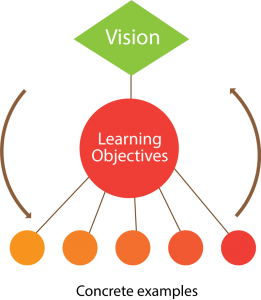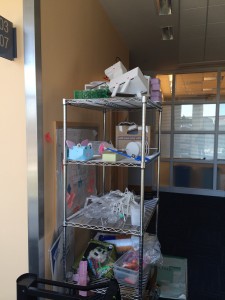Last week a group of PPI faculty fellows, including myself, traveled from Indiana to Massachusetts to learn details about the Olin College of Engineering. Our host was Mark Somerville, who kindly shared invaluable information about his experience forging this innovative culture, pedagogy and curriculum. It was helpful to hear about the processes and struggles that Olin had in the early stages of development starting in the late 1990s and throughout. Mark was very honest with us and we were lucky enough to get feedback on our ideas for the Purdue Polytechnic Initiative. The following post is the transcription of my notes during the visit, so I hope that others might find it helpful as well. In addition to Mark, I would like to thank the groups of students and faculty that guided us during the day. The conversations were very inspiring and helpful, as we are in the development stages of a new academic experience in Indiana.
Curricular models
One of the things that I was most curious about was on how to achieve a balance between a flexible curriculum and specific learning outcomes. Mark explained that in the beginnings, Olin started with a very flexible curriculum, but that with time it became not as much. It was hard to implement a wide variety of courses because of practical terms (time, staff, students), so they opted for having flexibility within the courses. It was also noted that it was important to set a degree pathway for students, rather than leaving it completely open.
The above graphic illustrates the gradual increase of student autonomy in time. The dots represent project or course sequences, meaning that the first experiences would have more scaffolding and less openness. The idea is to help the student develop their autonomy in gradual process. Mark highlighted here the importance of being intentional with the first projects, because students love to be successful. Having projects with no concrete deliverables might overwhelm the student or causing that the student creates a bigger project that he/she can accomplish.
When overhauling the curriculum, Mark identified three options: a) Starting building from a list of learning objectives, b) Content-driven and c) Higher level vision + experience design. At the origins of Olin, Mark and the rest of faculty initially approached the task of creating the curriculum with a content-driven approach: What is the minimum that an engineering graduate needs?
After a post-it brainstorming, the faculty realized that in order to accomplish those “minimum” requirements, the undergraduate students would need 8 years to go through program. Subsequently, they developed the higher-level vision model.
At Olin, the curriculum design is created through the Higher-level vision and experience design approach. The idea is to start asking concrete questions about the course experience, for example: Tell me the story of the third week of class. What would students be doing? How?
The above graphic shows an integrated high-level vision approach that uses concrete examples (projects) to inform the learning objectives and vice versa. The philosophy of curriculum design is more like designing an experience (like Disneyworld), instead of just starting from the learning objectives.
Below is a list of courses and projects that we learned about while we visited and serve as examples of the high level vision model in practice. The notes I have about these courses are the result of my conversations with Sharon Grimshaw, an Olin student who patiently explained to me in detail the Olin curriculum. This list and my notes are not complete, but my intention is to illustrate the type of educational experiences at Olin.
Mechanical Prototyping (aka) “Proto”
This semester, students were exploring the hand as a topic for new mechanical designs. Students explored different prototyping techniques such as 3D printing. I peaked through the window and saw several students sitting around a big table with their mechanical hands. The work was individual, but the professor was moderating a group critique of the projects.
Design Nature
Students work on 2 projects inspired by nature. One is “transporters” and the other is to design a toy for a 9 year old. The transporters is based on observing grasshoppers.
User Oriented Collaborative Design (UOCD)
This course is oriented towards identifying a design problem and teamwork. Students should stay away from technology and focus only on collaborative user experience design.
The course consists of:
- Ideation: Learn to identify problems
- Bring back to users and gather feedback
- Create visual aids and prototypes that solve the problem
The problem to solve is projected 20 years in the future, to invite students to think “outside the box.” The course takes place in a studio. Each team has their own space where they work throughout the semester.
Human Factors in Interface Design
Sharon described this course as a “sink or swim” course, combining one-half programming and one-half design. The course consists of one team project that solves an interface problem identified by the students. In team based classes, such as this and UOCD, students vote for ideas and conform groups as they wish. Additionally, they created the “silver bullet” mechanism that allows students to decide to not work with somebody in particular, such as a current boyfriend/girlfriend. The class has no lectures and it is just project based. Students identify competencies among their groups, like for example: Lead programmer or lead designer. Sharon explained: “You don’t have to learn how to program, but you can also learn if you want to.” This particular class is mainly focused on interface design for Web and Mobile apps.
Engineering for humanity
This class is co-taught by anthropology and engineering faculty. Students design projects aimed for underserved communities (elder, poor, etc.).
Physics
One lecture + Studios. Physics is taught through practical examples, projects and problems. Students focus on explaining the Why’s of observed physical phenomena, such as the speed of a basket ball. They also create theoretical simulations with MATHLAB.
Principles of Engineering
Arduino+ Design + Building systems. Combines computer code with mechanical, electrical and visual applications.
Modeling and control
Focuses on sensor and data aquisition. The course includes an experimental approach to analog sensors and filtering. Additionally to data collecting, students learn to analyze the datasets.
Digital Eye
A course on written composition and digital imaging.
Other courses: Robotics 2, Expedition atmosphere
Culture Building
Most of our visit consisted on being immersed in the Olin culture. That is the values shared by the individuals that belong to this community. It is difficult to describe how it feels to be at Olin, but it is certainly a unique place with unique cultural values. The student motivation was apparent not only on those students that gave us the tours, but everywhere we went. Students were rushing to get to the labs with not because a particular deadline, but because of a true engagement with their projects. Mark explained to us that part of the creation of the Olin culture begins in the admission process. While in a previous campus visit, students work on a one-day project. This allows them to create a bond with the community before classes actually start. It is also important to mention here that space drives behavior and the Olin campus is very inspiring. Walking through the hallways, I felt in a very creative and open-minded environment. Olin faculty created this culture by becoming truly sensitive to the student needs.
Feedback for PPI
Mark seemed very excited about the Purdue Polytech, and confirmed that we had all the right ingredients for a transformative educational experience (right people/right mindset). He addressed the fact that we have focused too much on abstract ideas and not so much on concrete examples. To me this was a wake up call to focus more on designing specific projects rather than just the learning objectives. I am very thankful to have been able to understand through the Olin example, what we need to do at Purdue. I realized that our task is not impossible!
See more pictures here



